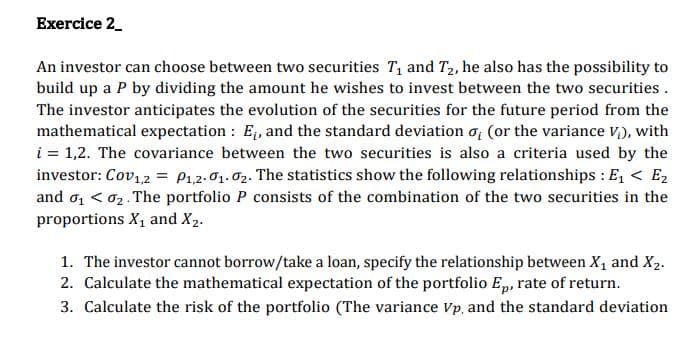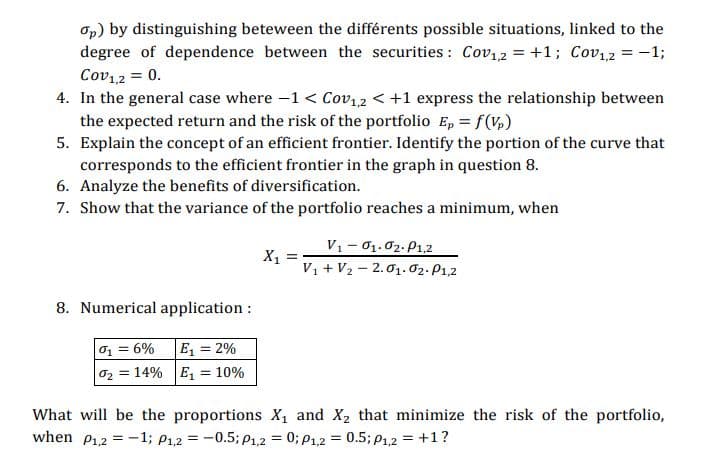n two securities T, and T2, he al nount he wishes to invest betw. olution of the securities for the and the standard deviation o (
n two securities T, and T2, he al nount he wishes to invest betw. olution of the securities for the and the standard deviation o (
Chapter8: Analysis Of Risk And Return
Section: Chapter Questions
Problem 16P
Related questions
Question
urgent plzzzzzzz

Transcribed Image Text:Exercice 2_
An investor can choose between two securities T1 and T2, he also has the possibility to
build up a P by dividing the amount he wishes to invest between the two securities .
The investor anticipates the evolution of the securities for the future period from the
mathematical expectation : E, and the standard deviation o; (or the variance v,), with
i = 1,2. The covariance between the two securities is also a criteria used by the
investor: Cov12 = P1,2.01. 02. The statistics show the following relationships : E, < E2
and o, < 02. The portfolio P consists of the combination of the two securities in the
proportions X1 and X2.
1. The investor cannot borrow/take a loan, specify the relationship between X, and X2.
2. Calculate the mathematical expectation of the portfolio Ep, rate of return.
3. Calculate the risk of the portfolio (The variance Vp, and the standard deviation

Transcribed Image Text:Op) by distinguishing beteween the différents possible situations, linked to the
degree of dependence between the securities: Cov12 = +1; Cov12 = -1;
Cov12 = 0.
4. In the general case where -1 < Cov12 < +1 express the relationship between
the expected return and the risk of the portfolio E, = f(V,)
5. Explain the concept of an efficient frontier. Identify the portion of the curve that
corresponds to the efficient frontier in the graph in question 8.
6. Analyze the benefits of diversification.
7. Show that the variance of the portfolio reaches a minimum, when
V1- 01.02. P1,2
X,
V, + V2 - 2.01. 02. P1,2
8. Numerical application :
0, = 6%
E = 2%
02 = 14% E, = 10%
What will be the proportions X, and X2 that minimize the risk of the portfolio,
when P12 = -1; P1,2 = -0.5; P1,2 = 0; P1,2 = 0.5; P1,2 = +1?
Expert Solution
This question has been solved!
Explore an expertly crafted, step-by-step solution for a thorough understanding of key concepts.
Step by step
Solved in 4 steps

Recommended textbooks for you

EBK CONTEMPORARY FINANCIAL MANAGEMENT
Finance
ISBN:
9781337514835
Author:
MOYER
Publisher:
CENGAGE LEARNING - CONSIGNMENT

EBK CONTEMPORARY FINANCIAL MANAGEMENT
Finance
ISBN:
9781337514835
Author:
MOYER
Publisher:
CENGAGE LEARNING - CONSIGNMENT